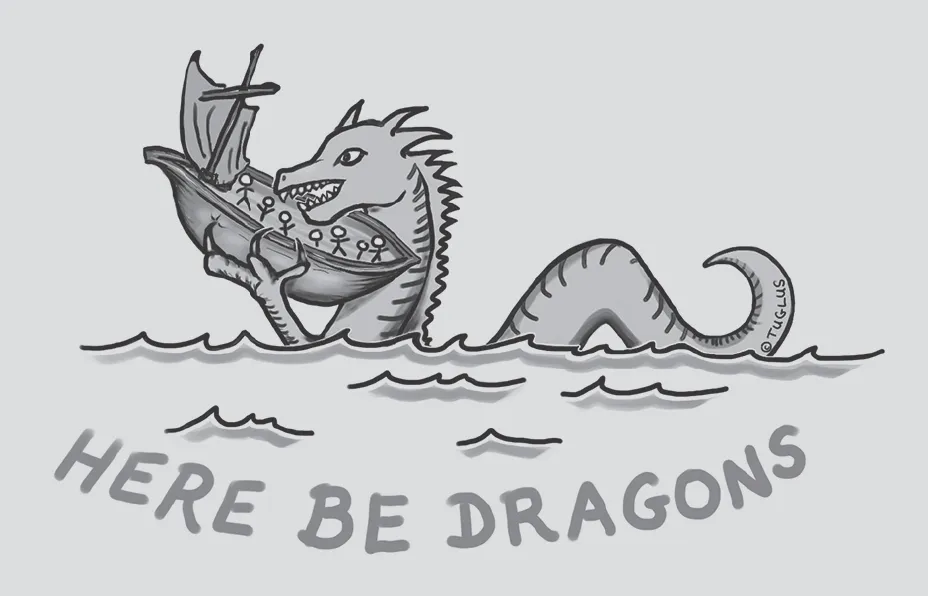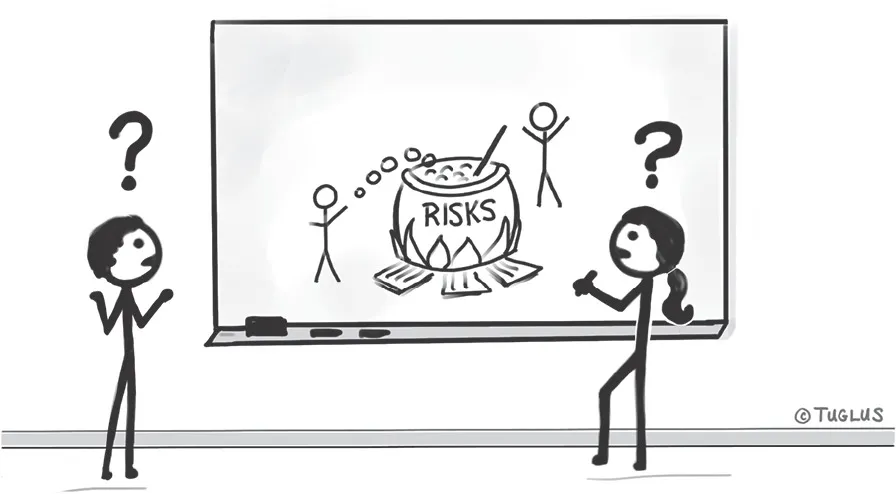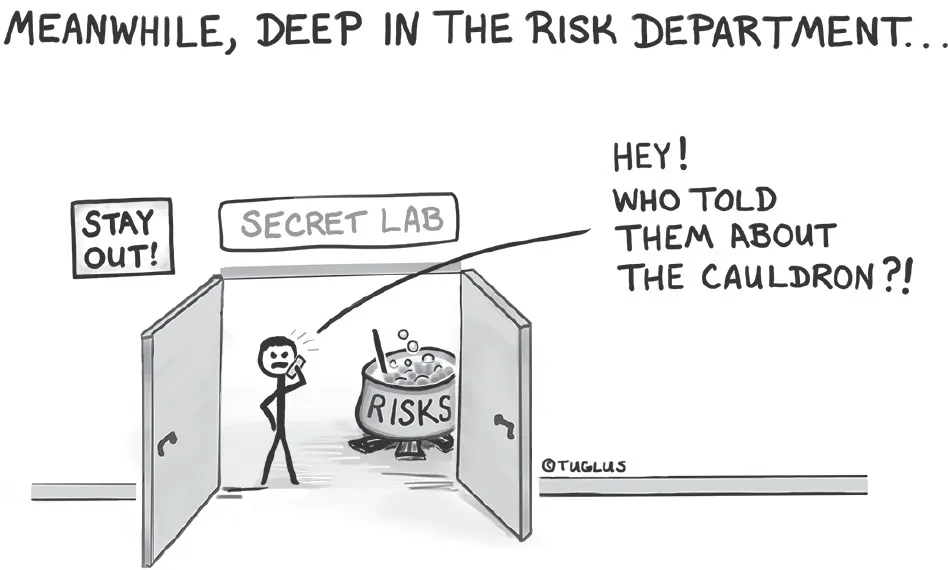![]()
1
Initiation
Understanding the Laws of the Land
WHEN EMBARKING UPON an unfamiliar journey, we can dramatically increase our chances of success by first educating ourselves on the laws of the land. Such laws convey the most critical dynamics of an ecosystem and terrain—and reveal how to best interact with it—in order to quickly and safely achieve our intended goals.
Recently, I spent some time hiking in Alaska. An excursion there involves wild animals, deep forests, ice fields, and glaciers. It is a land of many perils. While hiking, you might stumble upon a moose, a generally peaceful animal with poor eyesight that weighs a thousand pounds and could stomp you to death if provoked. Upon discovering a moose with a calf frolicking nearby, although tempted to get closer, I knew it was safer to keep my distance and made sure I never got between the two animals. I applied the same logic later, when a bear cub ambled onto the path in front of me—though I’ll admit to a brief moment of terror as I desperately scanned the forest for its much larger parent.
Before traveling, I had equipped myself with an understanding of the dynamics of the ecosystem that were most likely to impact my journey, so was thus prepared for the most common and dangerous challenges. I successfully navigated perils, avoiding being plunged into a crevasse, stomped on by a moose, or mauled by a bear. Successfully navigating any dangerous journey requires the proper initiation, and business transformation is no exception. There are many things that can impede, injure, or kill you during a journey in Alaska. Likewise, there are many things that can impede, injure, or kill the value of your business transformation. Your business journey must navigate numerous dragons and pitfalls in order to emerge victorious over fast-moving competition and the ever-changing world.
This chapter initiates you in the laws of transformation: the core dynamics of people and leadership that are most relevant and critical to the journey of business transformation. These five foundational laws will serve you well through all phases of your journey. You will find them widely applicable to leadership in general, but they are especially important for business transformation.
Successful transformation leadership is not about memorizing a list of activities to undertake, such as risk management, project planning, change control, and budgeting. It is about understanding the organizational system that you are changing and its dynamics; understanding the people within it and what drives them; knowing where you are taking them; and being skilled enough to maximize the business value of the entire endeavor.
In Alaska, it would have been only marginally helpful to memorize a list of threats—moose, bear, poisonous plants, crevasses. And it would have been overwhelming and time-consuming to research each possible peril in depth in an attempt to absorb all the details. What was truly important was to understand the core dynamics most relevant to the particular journey I was taking—for example, that animals can become dangerous when protecting their young, and how that could impact my journey. Understanding the core behaviors of the system not only aids in avoiding dangers, but also gives you the ability to think for yourself, enabling you to solve dangerous situations when they do emerge.
Accordingly, my transformation laws are designed to convey the underlying laws of the land of transformation, providing critical insights into organizational behavior and transformation leadership. These laws have emerged from my over twenty years of transformation experience. Taken to heart, they will give you a powerful advantage. As we explore them, do not try to memorize them precisely. Instead, strive to understand the core dynamics within them. There will be no multiple-choice test, I promise. Let’s take a look at my Laws of Transformation:
·It’s all people systems
·People fear the unknown
·Relativity reduces fear
·You need speed
·You are writing an epic tale
Tuglus Transformation Law #1: It’s All People Systems
I love getting to the core of something. Pulling it apart to see how it works. Identifying its central truths. Exploring the components and discovering the few, simple, underlying rules that make the system operate. Over the course of many years, I have taken apart almost every appliance in my home to see how it works. (I wait until they are broken. Honest.)
Similarly, getting to the heart of an organization can be invigorating. Like household appliances, organizations are also systems. But instead of gears and motors and wires and microchips, organizations are systems of people. And people systems are far more complex and interesting than mechanical systems. Which makes them a lot more fun.
You may never need to know how your microwave or furnace works. However, if you are embarking upon a transformation, you do need to understand the core dynamics of the system of people that you are transforming. Your very success depends upon it. People systems are at the heart of any transformation. Successful transformations take people on a journey, drawing on their sense of purpose, framing the future, dispelling unknowns, and building ownership in order to deliver real business value. Your success in instituting real change is directly proportional to how well you learn and master the system of people that you are transforming.
As you take your transformation journey—as you envision it and execute it—it is easy to become fixated on the seemingly more tangible aspects of the transformation. A cool new product with great market potential. Or an advanced technology platform. But I don’t care how great your technology solution will be, or what wonderful feat of engineering has been designed, or how amazing that product could be. If the system of people surrounding it—the employees and leaders—do not take ownership for achievement of the vision, and incorporate it to drive business value, then your entire journey will be meaningless. Choosing appropriate tools and solutions is important, but that is the easy part. The real challenge is all about people. And systems of people are complex. In any size. This is the first law of transformation because it underlies all others. Everything ahead will build upon this foundation.
DELVING INTO THE DYNAMICS: OWNERSHIP IS LOST AS ORGANIZATIONS GROW LARGER AND OLDER
In a ten-person company, the motivations and engagement of people are fairly obvious. It is easy to mobilize and make things happen. There is not much of a people system to figure out, and it is easy to engage the entire company to focus on big-picture business goals. This is one reason early stage start-ups are so invigorating.
As companies grow, separate functions form—marketing, engineering, editorial, communications—and accordingly, the feeling of ownership that people once felt for the entirety of the company now splits as well. Many new employees join, and they do not possess the same perspective, the same sense of ownership as the original employees. The result is that with every growth spurt, every influx of new people, the original sense of ownership erodes. Natural attrition of staff increases this effect as additional new people come on board. The larger the company grows, and the longer it lives, the less the average employee truly understands and cares about the big picture. The less ownership each one has. Figuring out how to lead those now disparate groups of people, and guide them to band together for the common good, is one of the core challenges of organizational leadership. And this challenge becomes magnified and amplified during times of transformation.
UNCOVERING THE MYSTERIES OF HUMAN BEHAVIOR
It was in a company of 200 people where I began to recognize the complexity of transforming people systems. It is challenging to get a system of people to collaborate effectively toward a common goal. Figuring out how to do this was not always fun for me. Initially, in fact, it was quite frustrating.
Recently, I found a picture I drew back then to demonstrate one of my frustrations. The “risk cauldron” was a concept I created to humorously describe some of the dysfunction I was experiencing. This drawing appeared on my whiteboard quite often, whenever I was discussing a particular challenge with colleagues. Every time we got close to making progress on key decisions on our project, there were two people who would stir the risk cauldron and bring up new “very concerning risks.” Frequently this would stop progress in its tracks. I was convinced that somewhere there was a secret cauldron of risks, from which they would pull whatever random risk bubbled to the top that day, and offer it up in the name of risk management.
This company was a small custom software shop with no official risk function. It was every person’s job to deliver the solution the client hired us to create, and risk management was an inherent part of solution delivery. Neither of the people stirring the cauldron had the official job to just attend meetings and raise risks all day long. Even when you have a formal corporate risk function, this unproductive passive-aggressive behavior should not occur. But let’s leave a deeper discussion of corporate risk for another day. Regarding that, for now, all I can say is watch carefully. If you see your risk professionals (or anyone, for that matter) tossing out seemingly random risks at inopportune times, check the depths of their department for a locked heatproof room . . .
Back to the story. It was not anyone’s job to bring up risks and then sit back and watch as meetings were derailed and progress hampered. So why were they doing this? I speculated that their goal was to avoid doing work by postponing status discussions. Or to look engaged as a substitute for work. Alternatively, they were evil masterminds who were doing both, appearing engaged by bringing up “risks” at strategic moments, in order to derail productive discussion and ultimately allow them to avoid real assignments. That was my leading hypothesis.
I had many hypotheses. However, they only went a layer or two deep. And they remained only hypotheses. At first, I did not dig far enough to really get into the intricacy of the people system, into the interconnections of influence and motivation in play, to truly figure out why they were doing this. I was just so amazed and frustrated by how the behavior of just one or two people could dramatically alter the productivity of a larger group. Publicly and directly challenging the risk cauldron stirrers, as a junior employee, just caused them to double down on their strategy and suggest that I didn’t know what I was talking about. So that didn’t work. For a while, I just let it annoy me. But it was so puzzling. Then I began to ask why. I started to look deeper, to investigate. To peel back the layers of behavior to see what was driving this. What was really going on, beneath the surface, when this situation occurred?
From this new perspective, I began to see a system at work. There were forces behind the behavior. Through individual conversations with the cauldron stirrers and others, connections emerged. Most notable was the discovery of a notorious project in recent past where the client had been unpleasantly surprised by a very visible issue in the product delivered to them. It was widely believed that the risk of this issue occurring could and should have been identified and prevented before product launch.
Upon learning this, I understood why some people might be overly sensitive to risks. It also became clear, however, that one of the cauldron stirrers was indeed taking advantage of this situation as I had originally hypothesized. In an act of self-promotion, they were liberally noting possible risks, unproductively, in an attempt to demonstrate how diligent and engaged they were. And others were allowing it due to the lingering shadow of that recent event.
These were not evil masterminds. They were part of a system. A system that could be investigated and understood.
It was a few years later, at Ford Motor Company, where I really learned about people systems. There is no better place to learn about people systems than a hundred-year-old global Fortune 10 company. The only place that could be better is the government. Which I also experienced, as a contractor on a large ...





